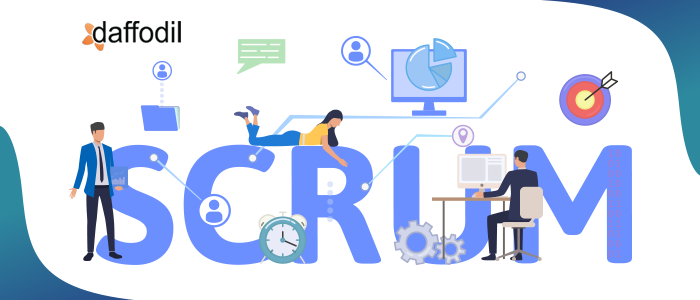
The software industry swears by the iterative approach to development. That is why Agile and its frameworks are the favorites of a project management team. Amongst the various Agile frameworks that are available for project management, Scrum, so far, has proven to be the most efficient one.
The reason being, it fits in for a project of any size or complexity. In fact, there are Agile scaling frameworks that have Scrum as the basis. It helps to manage priorities, keeps the team more aligned with the goal, and ensures that there is better visibility of the project to all the stakeholders.
A Scrum is led by a team of members who makes sure that the project execution is done as per the expected standards, in an empirical environment. There are three roles in a Scrum team- a Product Owner, a Scrum Master, and a development team. They all collaborate with each other, takes care of the client requirements, handle blockers, and ensures on-time delivery. Let’s understand their roles and responsibilities at an individual level.
Role 1: Development Team
A development team has all the people who are responsible to deliver a releasable increment of the product at the end of each sprint. This includes developers, quality analysts, designers (UI/UX), architects, business analysts, operations teams, etc. The development team (s) are cross-functional, i.e. members with a different skillset collaborate to build a product increment.
The size of a development team is decided on the basis of project requirements and is exclusive of the product owner and scrum master. Small and large development teams should be avoided in a Scrum. A small team may result in skill crunch, which may lead to a team’s inefficiency to deliver an increment, while a large team size may create complexity. That is why having more than nine members in a development team is not recommended in Scrum. As a workaround, different development teams of five-nine team members can be created who can then share a common architect, business analysts, or operations team.
The responsibilities of a Scrum development team include delivering product increments that are part of a sprint. To ensure transparency in sprints, there are standup meetings (also called daily Scrum). This meeting, which is usually (but not necessarily) facilitated by the scrum master has a discussion about the progress of the work, issues or blockers that a team encounters, seek help from fellow developers, etc. The entire Scrum team (development team, product owner, and scrum master) is a part of the standup meeting to ensure that there is transparency in the processes of the project.
Role 2: Product Owner
A product owner (PO) is a leader who is responsible for maximizing the value of products that are built by the development team. In doing so, the PO may take up the role of a business strategist, market analyst, or a product designer.
A product owner is a person in a Scrum team who is responsible for managing the product backlog. However, that doesn’t mean that he is the only one who could contribute to the backlog. A product backlog is usually available as user stories wherein members from the development team can contribute. But a PO should be informed about any additions or deductions made in the backlog.
Stakeholder management is another area where a PO has expertise. A product may have several stakeholders involved, ranging from the user, customer, organizational leadership, etc. The PO ensures that a value is delivered to all of them through the work delivered by the development team. His core responsibilities include:
1. Expressing product log items to the development team
2. Maintain an order of items in the product backlog to achieve the goals
3. Prioritize the backlog items in an empirical environment
4. Communicate with stakeholders to understand their requirements and business value
ALSO READ: Agile Project Management: How to Write Epic User Stories?
Role 3: Scrum Master
A scrum master is a facilitator in an Agile development team. Often called a chief impediment remover officer, the scrum master helps the product owner to define value, enables the development team to deliver the value, and ensures that the entire team abides by the rules of the Agile framework.
- The scrum master serves the product owner by helping them better understand and communicate the backlog. He/She also helps the PO in prioritizing the backlog tasks.
- The scrum master coaches the development team, helps them focus on their outcomes, manage blockers, and thereby helps them to increase their efficiency.
In a scrum team, there can either be a dedicated scrum master who ensures that the team follows the Agile development practices to manage fluctuating requirements while dealing with the changing requirements. On the other hand, the role of the scrum master can be played by anyone in the development team. In the latter case, the team is usually mature enough and is capable of handling challenges or blockers during development on their own.
Adopting Scrum in Agile Development Cycle
An Agile methodology is a client-centric approach to software development. It works best when the project requirements are dynamic and thus, we at Daffodil, follow the Agile approach for almost all of our projects. Scrum, which is our preferred Agile framework ensures that there is transparency in the development cycle to all the stakeholders. As a software development company, we ensure that our Scrum team performs their roles according to the defined standards and deliver output, as expected by the client.



